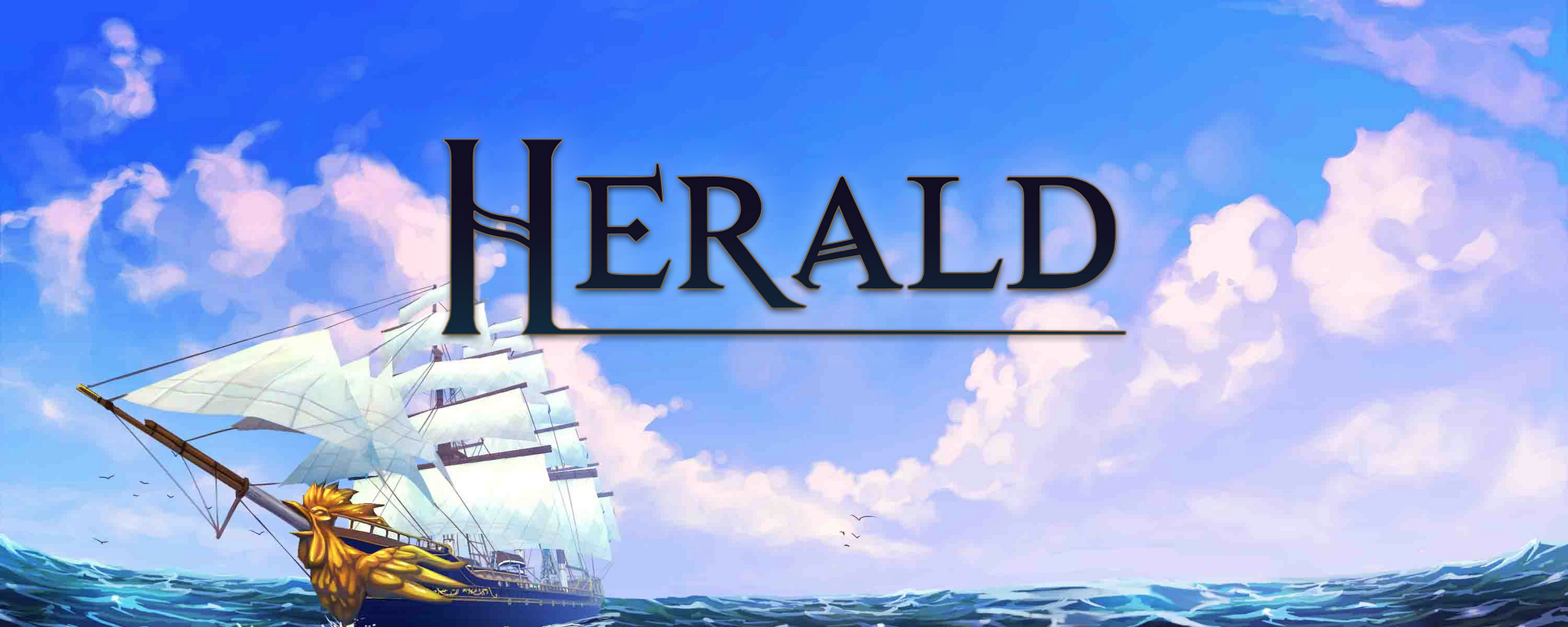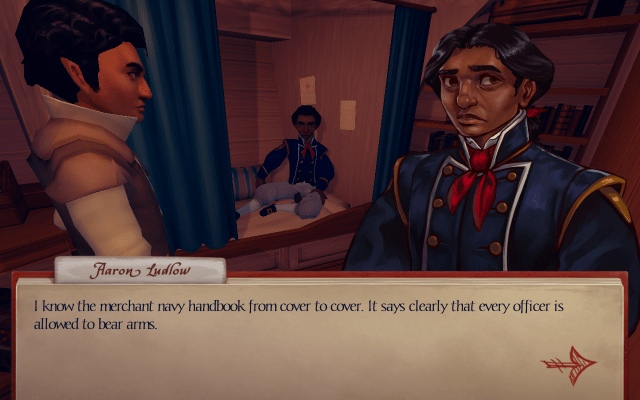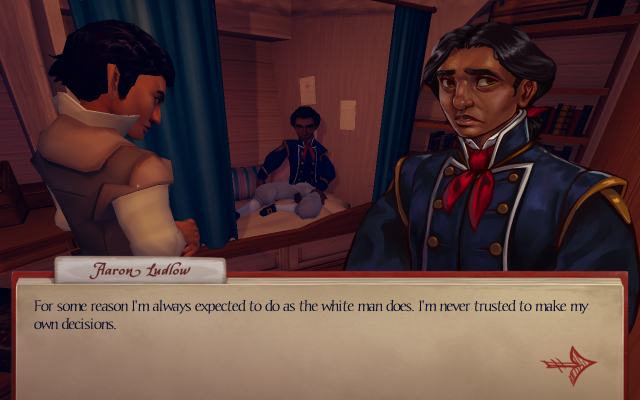The Mary Sue Interview: Roy van der Schilden and Aïda de Ridder on Herald, Colonialism, and Cultural Identity

The Mary Sue had a chance to chat with Roy van der Schilden and Aïda de Ridder, two developers behind the adventure game/visual novel Herald. Before our chat, I got to try out a quick demo of the game. The moment I fired it up, I knew I was in for something… different.
It drops you in medias res, and you quickly learn that you play Devan, a steward on the sailing ship HLV Herald. You’re tasked with finding a misplaced gun, and you do so with your traditional adventure game method: clicking literally everything.
What really makes Herald stand out, though, is its unique character design and its stand-out story about being a person of mixed race living in a world impacted by colonialism. There are bits and pieces in each of the clickable objects that shed light on a greater backstory, but the real meat of the game lies in its dialogue, which is shaped by the choices you do (or don’t) make.
Jessica Lachenal (TMS): So, tell me about Herald.
Roy van der Schilden: Herald is a mix between a point and click adventure and a visual novel. It’s a story about a man of mixed heritage on board the HLV Herald, which is a trading ship in the 19th century. He’s traveling back to the east, back to his country of birth in the eastern colonies.
However, he was raised in the west. So, during the game, you work yourself up the hierarchy in the ship, but you’re mainly a steward, so you’re the one who solves conflicts on behalf of all the passengers and crew on board.
Because Herald is a game about mixed heritage, basically he’s half colony native and half “western.” What’s important is that you can make decisions based on this spectrum. You can make “colony decisions,” which are decisions tailored to the needs of the colonized aboard the ship, and you can make decisions that are more “empire,” that are tailored to the protectorate, which is the fictional empire the game has. It’s not clear which decision is which, so you have to think carefully about it to try to predict the consequences.
TMS: Why did you choose this period? What drew you to this period in particular?
Aïda de Ridder: I guess we just really liked the 19th century. It’s a very interesting time. It’s mostly based in 19th century Britain, but we’ve also mixed in some of 17th century Holland, because that’s our country, which is also very trade-heavy. We did a lot of trading at that time, it was a very romanticized period in history, but in school you rarely learn about the issues of colonialism and stuff like that.
I think it’s very interesting because we don’t know so much about it, at least in our country. So when we started researching it, it’s like there’s a lot of story involved that we could use.
TMS: You mentioned that it was kind of a romanticized time, but I wondered, why a sailor’s journey in this period? Why aboard a ship?
van der Schilden: Well, we really saw the ship as a good metaphor for society. On board the ship you have people of many different backgrounds who all have to work together to get the ship to its destination. So, the Herald is a microcosm of society. We deliberately chose a ship and the journey as a metaphor, basically.
Specifically talking about the period setting, this is just something that really fits the 19th century. It is an aesthetic choice that a lot of people in gaming tend to shy away from, maybe because it’s more… feminine, I guess? I still think a lot of game styles, Assassin’s Creed for example, are very masculine. But we deliberately chose the period drama setting because we think it fits the story we want to tell.
It’s more personal, it’s more about characters and less about grand spectacular explosions and things.
TMS: In talking about aesthetic, I noticed that the art choice was very unique. It’s something that really stood out to me as very striking. What led you to this design, what drew you to this style?
de Ridder: We really wanted to play to our strengths as a small developer. I’m a 2D artist, and I think that’s a strength we should use, and we really wanted to focus on the 2D art. The 3D art we chose because we wanted the player to be engaged in the setting, we wanted them to be able to walk around and look at the setting.
But we wanted to try to blend those two styles together by using the hand painted textures in the models. We wanted to make the 2D characters more interesting, so I decided to try to animate them, which I’m really happy I tried to do. I’m not really an animator, but when we started to animate, they really came alive for me. I think that really helps the look of the game.
TMS: So how far along would you say development is right now?
van der Schilden: We’re currently finishing chapter one, or at least we’re busy with making chapter one. All of the features are programmed, basically, but we’re still trying to make the content right now. So, we’re going to release the first part next year in February, and the second part in October of 2016. The first part will have two chapters, and we’re well on our way with chapter one right now.
TMS: How’s the reception been?
de Ridder: We’ve gotten a lot of feedback, a lot of positive noise. So I’m really happy about that. I’m actually happy that we got some feedback that we can actually use because before that, everyone was just like, “Oh, it’s amazing,” but they never gave us any actual feedback. We can actually use some of the things people have said to us to make the game better, so I’m really happy about that.
van der Schilden: It’s really cool to see that people like the game and like the idea and what we’re trying to aim for. It’s hard to get a reach as a small developer. I think that the biggest problem we have right now is trying to reach the big audiences.
We had some very nice press, but it’s hard to create a community around a game that’s single player. You see a lot of indie games that are multiplayer and have these communities because they can play early access or demo versions of them together. Our game is a very personal experience, it’s something you do alone. You don’t share it as much unless you really love the game, and you want to talk with other people about it.
de Ridder: It’s also a challenge at conventions, because the game is so calm. When you’re in this busy convention hall and there’s all this music and there’s this fighting game next to you, trying to let people experience your game is hard.
TMS: How difficult was it to bring all the dialogue in the game together?
de Ridder: Very difficult.
van der Schilden: Yeah, very difficult. I had a bit of a struggle like, how can I do this topic justice? How can I write something as a white Dutchman about colonialism, about a mixed-heritage guy in the 19th century?
I came to the conclusion that I just had to do very good research. I had to talk to people, and be open to new ideas, offer multiple perspectives. It’s not just Devan’s perspective in the game, there are all these different characters who embody many different ideas. Through them, I want to give the players choice as well.
Sometimes some answers and choices you make in the game will lead to the same consequences. This doesn’t matter as long as the characters reflect on them in different ways. They should at least acknowledge that you made a different choice, even though it ended the same.
TMS: Why was exploring this relationship between being of mixed race and colonialism such an important subject for you to tackle?
de Ridder: Because we have a past in it in our country. Right now, there’s also some issues arising because of it. We just notice how undereducated people are in our country about this topic in history, which is a really interesting time that has affected us a lot of ways right now. So, it’s what first drove us to this subject matter; we wanted to learn about it, and see how much it’s affected us as a country today. We wanted to explore that in the theme of the game.
van der Schilden: For me, personally, I have a really hard time with the fact that a lot of Dutchmen think it’s normal to say, “Well, you live in the Netherlands, you adapt to this country that you live in,” and you forget the entire identity you had when you arrived.
That’s something you can’t just ask of people. You can want it, and you can reward it when they do it in certain ways, I guess, but with Herald, I want to show people that it’s not just something you do. It’s about possibly giving up parts of your identity when you choose to adopt other things. You have to make choices, that’s why it’s a choice-driven narrative.
—–
Herald‘s campaign is currently in its last few days on Kickstarter (ending May 25th) and it’s close to being funded!
—Please make note of The Mary Sue’s general comment policy.—
Do you follow The Mary Sue on Twitter, Facebook, Tumblr, Pinterest, & Google +?
Have a tip we should know? [email protected]






